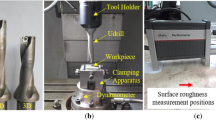Abstract
In recent years, a lot of extensive research work has been carried out in drilling operations for achieving better hole quality. Drilling operation is one of the machining processes, and it widely used in aeronautical and automotive industries for assembling the parts. The surface roughness is one of the significant factors in drilling operation because the poor surface finish will affect the material condition during the assembly. The spindle speed and feed rate are the important factors to affect the surface finish. In addition, the detailed analysis of the thrust force is also to be investigated for characterizing the cutting process. However, for examining the machining characteristics more trial runs are required, and it increases the time and cost of the experiment. In this paper, the integration of fuzzy logic (FL) with response surface methodology (RSM) has been introduced to reduce the cost and the time consumption for investigation. The low, middle, and upper levels of spindle speed with low and upper levels of feed rate combinations were examined on cutting force and surface finish through the experimental setup with the systematic manner. The FL model for thrust force and surface finish were obtained from the collected experimental data. The FL model has developed another two combinations of data without experimentation through universal partitioning. The results show that the predicted FL values are within the range of experimental value. Therefore, the FL model values were selected for further investigation with RSM. The result of FL-RSM model values are also within the range of experimental value. The proposed FL-RSM model and FL model are validated with experimental results. Finally, the validated results show that hybrid FL-RSM produces the effective output than the FL model.
Similar content being viewed by others
References
Ribeiro MV, Moreira MRV, Ferreira JR (2003) Optimization of titanium alloy (6Al–4V) machining. J Mater Process Technol 143–144:458–463
Kurt M, Kaynak Y, Bagci E (2008) Evaluation of drilled hole quality in Al 2024 alloy. Int J Adv Manuf Technol 37:1051–1060
Sharif S, Rahim EA (2007) Performance of coated- and uncoated-carbide tools when drilling titanium alloy-Ti6Al4V. J Mater Process Technol 185:72–76
Strenkowski JS, Hsieh CC, Shih AJ (2004) An analytical finite element technique for predicting thrust force and torque in drilling. Int J Mach Tools Manuf 44:1413–1421
Kao JY, Tsao CC, Wang SS, Hsu CY (2010) Optimization of the EDM parameters on machining Ti–6Al–4V with multiple quality characteristics. Int J Adv Manuf Technol 47:395–402
Cus F, Zuper U (2006) Approach to optimization of cutting conditions by using artificial neural networks. J Mater Process Technol 173:281–290
Baek DK, Ko TJ, Kim HS (2001) Optimization of feed rate in a face milling operation using a surface roughness model. Int J Mach Tool Manuf 41:451–462
Fernandes M, Cook C (2006) Drilling of carbon composites using a one shot drill bit. Part I: Five stage representation of drilling and factors affecting maximum force and torque. Int J Mach Tool Manuf 46:70–75
Gaitonde VN, Karnik SR, Paulo Davim J (2008) Taguchi multiple-performance characteristics optimization in drilling of medium density fibreboard (MDF) to minimize delamination using utility concept. J Mater Process Technol 196:73–78
Gaitonde VN, Karnik SR, Achyutha BT, Siddeswarappa B (2008) Genetic algorithm-based burr size minimization in drilling of AISI 316 L stainless steel. J Mater Process Technol 197:225–236
Bagci E, Ozcelik B (2005) Analysis of temperature changes on the twist drill under different drilling conditions based on Taguchi method during dry drilling of Al 7075-T651. Int J Adv Manuf Technol. doi:10.1007/s00170-004-2569-6
Tsao CC, Hocheng H (2008) Evaluation of thrust force and surface roughness in drilling composite material using taguchi analysis and neural network. J Mater Process Technol 203:342–348
Longella A, Nele L, Maio A (2005) A torque and thrust prediction model for drilling of composite materials. Compos Part A 36:83–93
Zitoune R, Collombet F (2007) Numerical prediction of the thrust force responsible of delamination during the drilling of the long fiber composite structures. Compos Part A 38:858–866
Noorul Haq A, Marimuthu P, Jeyapaul R (2008) Multi response optimization of machining parameters of drilling Al/SiC metal matrix composite using grey relational analysis in the Taguchi method. Int J Adv Manuf Technol 37:250–255
Karthikeyan R, Jaiganesh S, Pai BC (2002) Optimization of drilling characteristics for Al/SiCP composites using fuzzy/GA. Met Mater 8(2):163–168
Arghavani J, Derenne M, Marchand L (2002) Prediction of gasket leakage rate and sealing performance through fuzzy logic. Int J Adv Manuf Technol 20:612–620
Tarng YS, Yang WH, Juang SC (2000) The use of fuzzy logic in the Taguchi method for the optimization of the submerged arc welding. Int J Adv Manuf Technol 16:688–694
Sharma V, Chattopadhyaya S, Hloch S Multi response optimization of process parameters based on Taguchi–fuzzy model for coal cutting by water jet Technology. Int J Adv Manuf Technol. doi:10.1007/s00170-011-3258-X
Fernandes M, Cook C (2006) Drilling of composites using a one shot drill bit. Part 1. Five stage representation of drilling and factors affecting maximum force and torque. Int J Mach Tools Manuf 46:70–75
Kurt M, Bagci E, Kaynak Y (2009) Application of Taguchi methods in the optimization of cutting parameters for surface finish and hole diameter accuracy in dry drilling processes. Int J Adv Manuf Technol 40:458–469
El Baradie MA (1997) A fuzzy logic model for machining data selection. Int J Mach Tools Manuf 37(9):1353–1372
Author information
Authors and Affiliations
Corresponding author
Rights and permissions
About this article
Cite this article
Kumar, B.S., Baskar, N. Integration of fuzzy logic with response surface methodology for thrust force and surface roughness modeling of drilling on titanium alloy. Int J Adv Manuf Technol 65, 1501–1514 (2013). https://doi.org/10.1007/s00170-012-4275-0
Received:
Accepted:
Published:
Issue Date:
DOI: https://doi.org/10.1007/s00170-012-4275-0




